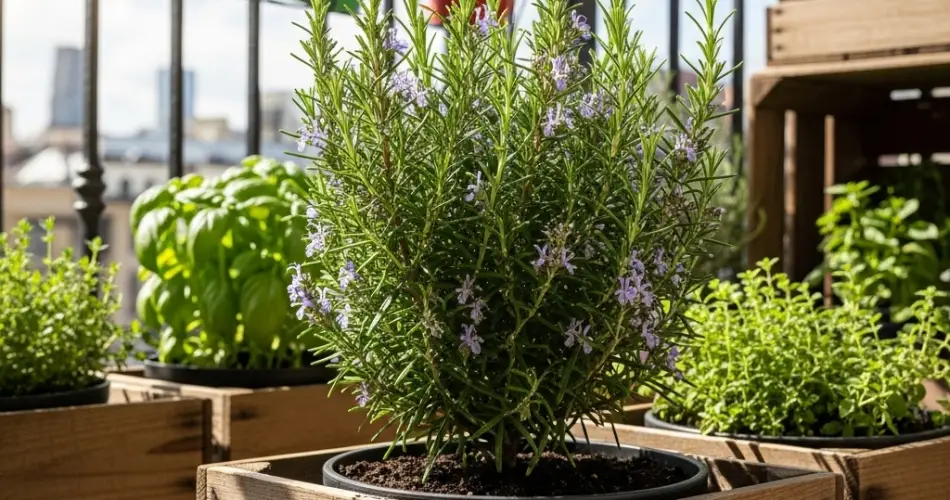Balcony gardening has become a popular way to grow fresh produce and herbs in urban environments. Among the many herbs you can grow, rosemary stands out for its aromatic fragrance, culinary versatility, and resilience. By using sturdy crates as planters, you can create a functional, attractive, and space-efficient rosemary garden right outside your door. This approach is not only practical but also sustainable, as it allows you to reuse materials while enjoying a steady supply of fresh herbs year-round.
Why Rosemary is Ideal for Balcony Gardens
Rosemary is a hardy perennial that thrives in sunny conditions and requires minimal maintenance once established. Its needle-like leaves and woody stems store essential oils that give it its distinct aroma and flavor. It is perfect for seasoning meats, potatoes, breads, and even herbal teas. Beyond culinary uses, rosemary adds ornamental value to your balcony with its evergreen foliage and delicate blue or purple blooms in spring.
This herb is naturally drought-tolerant and can survive in relatively poor soil conditions, making it a great candidate for container planting. When grown in crates, it benefits from excellent drainage while still having room for healthy root growth.
Choosing the Right Crate for Rosemary
Not all crates are created equal. Since rosemary can grow quite large and live for many years, your planter needs to be sturdy and weather-resistant.
Crate selection tips:
-
Material – Opt for wooden crates made from untreated, rot-resistant wood like cedar or hardwood. Plastic crates can also work if they are UV-resistant and durable.
-
Size – A depth of at least 25–30 cm is ideal to allow strong root development.
-
Drainage – If the base is solid, drill several holes to let excess water escape.
-
Lining – Use breathable fabric, burlap, or landscape cloth to hold soil while preventing it from washing out.
Adding caster wheels can make moving the crate easier, especially when you need to adjust for sunlight or bring the plant indoors in winter.
Preparing the Soil Mix
Rosemary prefers well-drained soil with a slightly sandy texture. A suitable crate planting mix can be made by combining:
-
2 parts quality potting soil
-
1 part coarse sand or perlite
-
1 part compost for slow-release nutrients
Avoid heavy clay or overly rich soil, as these can lead to water retention and root rot.
Planting Rosemary in Crates
You can start rosemary from seeds, cuttings, or nursery plants. Seeds can be slow to germinate, so many gardeners prefer cuttings or young plants.
-
From cuttings – Take a healthy stem about 10 cm long, strip off the lower leaves, and insert it into moist soil. Keep it in a warm, bright spot until roots develop.
-
From nursery plants – Choose a compact, healthy plant and transplant it into your prepared crate, making sure to keep the root ball level with the soil surface.
Space plants at least 30 cm apart if growing more than one in the same crate, as rosemary can spread out with time.
Sunlight and Watering Needs
Rosemary thrives in full sun, requiring at least 6–8 hours of direct light daily. Position your crate in the sunniest part of your balcony, such as a south-facing spot.
Water sparingly—rosemary prefers slightly dry conditions. Water only when the top few centimeters of soil are dry to the touch, and avoid soaking the plant’s base for long periods. Overwatering is one of the most common causes of rosemary decline in containers.
Feeding and Pruning
Fertilize lightly once a month during the growing season with a balanced organic fertilizer or a slow-release herb feed. Too much nitrogen can lead to excessive leaf growth and reduced aroma.
Prune regularly to encourage branching and maintain shape. Harvest sprigs as needed, cutting just above a leaf joint to promote fresh growth. This will also prevent the plant from becoming too woody.
Seasonal Care for Balcony-Grown Rosemary
-
Winter protection – In cooler climates, bring the crate indoors to a bright, sunny window during winter or cover the plant with frost protection fabric.
-
Pest control – Rosemary is relatively pest-resistant, but keep an eye out for spider mites or aphids.
-
Re-potting – Every 2–3 years, refresh the soil mix and trim the roots to keep the plant vigorous.
Using Your Fresh Rosemary
Fresh rosemary enhances roasted vegetables, grilled meats, bread, marinades, and infused oils. Its strong aroma can also be used in home fragrance sachets or simmer pots. Dried rosemary keeps its flavor well, so excess harvests can be hung to dry in a cool, airy space and stored in jars.
Final Thoughts
Balcony gardening with sturdy crates offers a stylish, functional way to grow rosemary even in limited spaces. With proper sunlight, well-drained soil, and occasional pruning, you can enjoy a thriving rosemary plant that provides year-round harvests. The combination of rustic crates and lush green foliage adds character to your outdoor space while delivering fresh, fragrant herbs for your kitchen.



